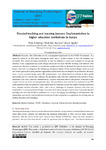| dc.description.abstract | Education, like all the other sectors, was impacted significantly by the COVID-19 pandemic. In a
report by UNESCO, in 2020 alone, learning for more than 1.7 billion children in over 188 countries was
disrupted. This forced education institutions to seek for alternative means and strategies to salvage the
situation. Crash programmes on course design and on how to move blended teaching were initiated. This
research was therefore conducted to establish the adoption and effect of blended education in universities in
Kenya. The study was hinged on the Technology Acceptance theory. Mixed method design which involved
use of both quantitative and qualitative approaches of data collection was adopted. In quantitative, the study
used a survey research design where 500 questionnaires were administered to students in three public
universities and two private ones in Kenya. For qualitative data, interview schedules were served to 20 key
informants who were university administrators, lecturers, education officers and parents. Selections of the
sample sizes for the study were purposively done. The quantitative data collected was analyzed using SPSS
while qualitative data was analyzed using content analysis. Findings revealed that higher learning institutions
have adopted blended education albeit with a lot of challenges to students, lecturers and other key
stakeholders. It recommended that Higher Education Institutions and governments should promote blended
learning even after the COVID-19 pandemic as a way of leveraging on technological advancements. The
information may also be used to enhance formulation of relevant policies or supplement the existing ones on
matters education and technology. | en_US |

